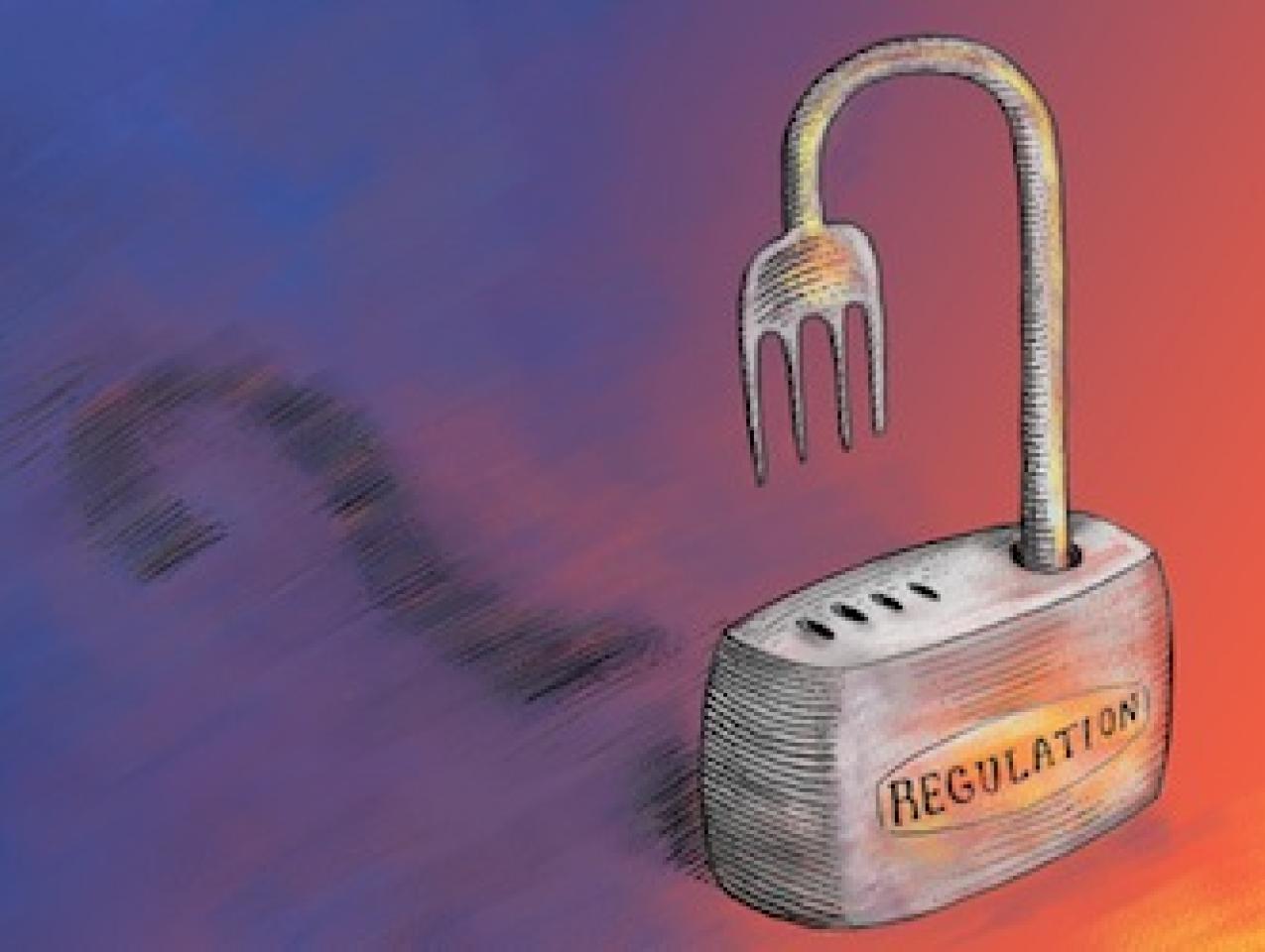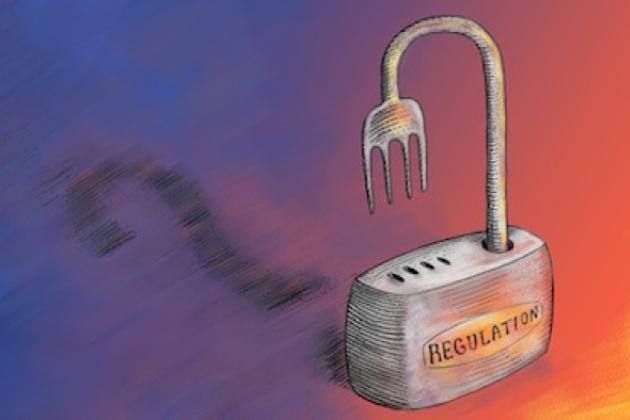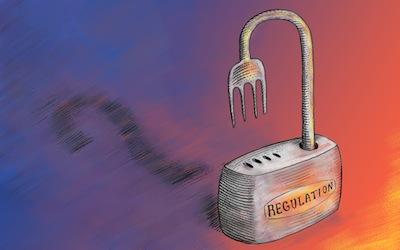- Economics
- Law & Policy
- Regulation & Property Rights
- Energy & Environment
- Politics, Institutions, and Public Opinion
The desire to support local farmers is admirable. But sentiment should not keep us from thinking critically about the consequences of coerced locavorism—that is, forcing municipal hospitals, schools, and other institutions to source an arbitrary percentage of their foods locally. But that is precisely what various cultural and political luminaries are suggesting we do.

Illustration by Barbara Kelley
For example, U.S. Representative Chellie Pingree (D-Maine), with seven co-sponsors, introduced the “Eat Local Foods Act” in 2011. The legislation, which was not enacted, would have subsidized local food purchases in school lunch programs. The best-selling author of The Omnivore’s Dilemma, Michael Pollan, has similarly argued that “in the same way that federal procurement is often used to advance important social goals… we should require that some minimum percentage of government food purchases” be sourced within 100 miles of where they are consumed. He continues in an Orwellian manner: “People will have to relearn what it means to eat according to the seasons.”
Another self-anointed member of the food police, Berkeley restaurateur Alice Waters, believes “that the most political act we can commit is to eat delicious food”—as long as it is produced in ways that reflect her elitist view of the world. As she says: “We need to pay for the food and pay the people who produce it. That’s profound and terribly important. We still think we can get it for free. And you know, it’s that idea that we have been indoctrinated to believe, that food should be fast, cheap and easy. And it’s really that kind of thinking that is destroying the world.”
For a full sense of how elitist much of today’s food activism is, consider Pollan’s argument that shopping at Whole Foods is a “literary experience.” Much of the food, he observes, is
’certified organic’ or ‘humanely raised’ or ‘free range.’ But right there, that’s the point: It’s the evocative prose as much as anything else that makes this food really special, elevating an egg or chicken breast or bag of arugula from the realm of ordinary protein and carbohydrates into a much headier experience, one with complex aesthetic, emotional, and even political dimensions.
The Economics of Local Food Production
To these people and others, locavorism is deemed worthy of government subsidies, which indeed it already receives. Along with a few other cities, New York doubles the value of food stamps when used at farmer’s markets. Although a reasonable debate can be had on the merits of subsidizing healthy food, it is far from clear why such especially salubrious food must be local to be eligible for the subsidy. Does a single mother of four living at the poverty line really have nothing better to do with her time than take a leisurely stroll down to the farmers’ market to buy fresh ingredients that require peeling, chopping, and boiling?
Why does locavorism need public subsidies? Local foods may well be tastier (if you live in the right spot at the right time of year), in which case few people would need coercion to purchase them.
Further, a basic understanding of economics reveals that the larger a farm grows, the more efficient it tends to become, given the large capital investment that is required for farming equipment. Thus, the per-unit costs of production are often much lower on larger farms. A study of Illinois farms showed, for example, that average total costs were 82 percent lower on soybean farms and 38 percent lower on corn farms that were larger than nine hundred acres, as compared to those that were smaller than three hundred acres. Another study showed that average incremental costs were 85 percent lower on dairy farms with herd sizes greater than 2,000 as compared to those with fewer than 30 cows.
But in order to take advantage of these economies of scale, farms need a large market, and policies that restrict sales to certain locations will limit the size of the market. Also, policies whose main goal is to support smallness in itself tend to promote inefficiency, and less-efficient production does not bode well for the environment because it means that more inputs are required to create the same amount of output.
Inefficient and Inconvenient
Not all food celebrities share the locavore orthodoxy of Pollan and Waters. Jacques Pépin—chef, restaurateur, TV star and author of Fast Food My Way and More Fast Food My Way—uses “the supermarket the same way you use a prep cook in the restaurant—slicing mushrooms, washing spinach. The supermarket does the work now. At the store I’d grab filet of sole, then put some mushrooms, shallot[s and] white wine with it. I can do that dish in five minutes now. Or I can go to the supermarket now and get boneless, skinless breast of chicken. It’s more convenient.” And you can bet that all the main ingredients in Pepin’s sole and chicken recipes—especially the wines—are not from local sources.
Moreover, there is more than a soupçon of hypocrisy among the high priests of locavorism. The wine list at Waters’ Chez Panisse restaurant in Berkeley—less than an hour’s drive from scores of California’s premier wineries in Sonoma and Napa counties—is dominated by European wines. And then there is this gem from Waters about what she was drinking during a September 2012 visit to New York: “a sparkling rosé from the Loire over crushed ice. That was a welcome respite from the heat on a recent visit to New York.” Mon Dieu! (Note: Long Island wineries make some delicious crisp and refreshing white wines.)
But let’s get beyond the condescension, elitism, and hypocrisy, and look at actual impacts of locavorism.
The locavores seem to have missed other important lessons of Economics 101—namely, the benefits of specialization and comparative advantage. By letting people specialize in those things that they are relatively good at making and then trading with others, we all become richer and better off than if we all tried to be self-sufficient. It’s no coincidence that the cultivation of crops such as corn, wheat, potatoes, and grapes is clustered in certain parts of the country best suited to them.
And in spite of what one might intuit, chances are that buying local isn’t any more environmentally friendly.
Although local foods do travel fewer miles, there is much more to calculating environmental impact than food miles. The vast majority of greenhouse-gas emissions occur near where the commodity is produced. As a result, it is logical to find the most efficient spots to grow fruits and vegetables and, from there, to ship them to other regions.
But many people misunderstand energy consumption. A landmark study found that with respect to energy consumption and greenhouse-gas emissions, it is four times more efficient to bring lamb raised in New Zealand to England rather than to consume English lamb. The reasons pertain to the comparative advantage and the low costs of sea transportation: New Zealand’s ample grasslands mean less need for supplemental feed and fertilizer than are required to raise sheep in England, advantages that more than offset the extra energy required to ship the meat to London.
We should be more concerned about the energy required to get ourselves collectively to the supermarket than the amount it takes to deliver a trailer-truckload of Georgia-grown Vidalia onions or Florida oranges to Wisconsin.
The underlying principle is—or should be—this: Your local farmer is probably better at growing some things than ours is, and vice versa.
We favor eating delicious and nutritious foods, but if we are to live by the locavore’s mantra, and only consume what can be made locally, we had better resign ourselves to an expensive, narrow and boring diet—especially if we live in climates with harsh winters and short growing seasons.
No one should be opposed to patronizing nearby farmers’ markets for fresh products in season—or, for that matter, to individuals opting to adopt fad diets or home remedies. But it is abusive for governments to subsidize the locavore movement, in which the state has scant economic interest and for which legislators should have little appetite.
















